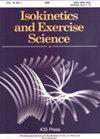不同时间拉伸对小腿肌肉力量的影响
IF 0.6
4区 医学
Q4 ENGINEERING, BIOMEDICAL
引用次数: 0
摘要
背景:关于拉伸对肌肉力量的急性影响,有相互矛盾的报道。一些研究报告肌肉力量下降,但其他研究报告拉伸后没有变化。目的:评估不同持续时间的静态拉伸(SS)对小腿肌肉等长最大自主收缩力(MVCF)的急性影响。方法:采用测试前-测试后实验设计。10名男性参与者(平均年龄25.4±2.11岁)参加了三项实验试验:SS 2分钟(SS2)、4分钟(SS4)和8分钟(SS8)。在拉伸前、拉伸后立即、拉伸后10分钟和20分钟测量MVCF。每次SS试验包括30秒拉伸和20秒放松期的不同重复。等长最大自主收缩力(MVCF)是测量结果的指标。结果:SS2、SS4和SS8在拉伸后0、10和20分钟的时间间隔内没有改变MVCF(p>0.05)。结论:2、4和8分钟的间歇性SS在拉伸后20分钟内没有改变小腿肌肉的等长肌肉力量,因此可以在需要显著肌肉力量的运动项目之前安全地进行。本文章由计算机程序翻译,如有差异,请以英文原文为准。
Time-based effects of different duration stretching on calf muscle strength
BACKGROUND: There are conflicting reports on the acute effects of stretching on muscle strength. Some studies report reduction in muscle strength however others report no change following stretching. OBJECTIVE: To assess the acute effects of static stretching (SS) of different durations on the isometric maximum voluntary contraction force (MVCF) of the calf muscle. METHODS: Pretest-posttest experimental design was used. Ten male participants (mean age 25.4 ± 2.11 years) participated in three experimental trials: SS for 2-minutes (SS2), 4-minutes (SS4), and 8-minutes (SS8). MVCF was measured before, immediately after, at 10- and 20-minutes post-stretch intervals. Each SS trial involved varied repetitions of 30-seconds stretches and 20-seconds relaxation periods. The isometric maximum voluntary contraction force (MVCF) was the outcome measure. RESULTS: SS2, SS4, and SS8 did not change the MVCF at 0-, 10- and 20-minutes post stretching intervals (p> 0.05). CONCLUSIONS: 2-, 4-, and 8-minutes intermittent SS did not change the isometric muscle strength in the Calf muscle up to 20 minutes after stretching and thus can safely be performed before those sporting events that require significant muscle strength.
求助全文
通过发布文献求助,成功后即可免费获取论文全文。
去求助
来源期刊

Isokinetics and Exercise Science
医学-工程:生物医学
CiteScore
1.20
自引率
14.30%
发文量
37
审稿时长
>12 weeks
期刊介绍:
Isokinetics and Exercise Science (IES) is an international journal devoted to the study of theoretical and applied aspects of human muscle performance. Since isokinetic dynamometry constitutes the major tool in this area, the journal takes a particular interest in exploring the considerable potential of this technology.
IES publishes studies associated with the methodology of muscle performance especially with respect to the issues of reproducibility and validity of testing, description of normal and pathological mechanical parameters which are derivable from muscle testing, applications in basic research topics such as motor learning paradigms and electromyography. The journal also publishes studies on applications in clinical settings and technical aspects of the various measurement systems employed in human muscle performance research.
The journal welcomes submissions in the form of research papers, reviews, case studies and technical reports from professionals in the fields of sports medicine, orthopaedic and neurological rehabilitation and exercise physiology.
 求助内容:
求助内容: 应助结果提醒方式:
应助结果提醒方式:


